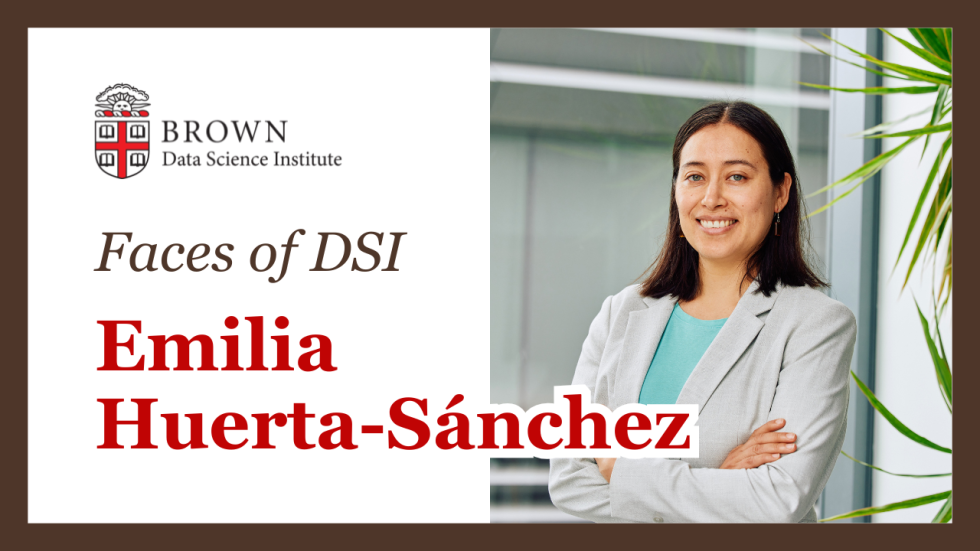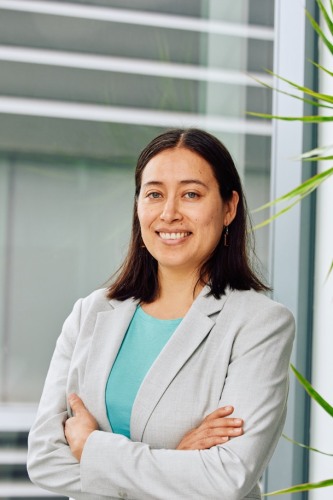Editor’s note: This interview has been edited for clarity.
Who are you and what do you do at the Data Science Institute (DSI)?
My name is Emilia Huerta-Sánchez, and I have been at Brown since 2018. I direct the Center for Computational Molecular Biology [at the Data Science Institute] and I am also a Professor in the Department of Ecology, Evolution and Organismal Biology.
What do you research at Brown?
I am a population geneticist, and my research focuses on analyzing large-scale genetic data to learn about human history. A single human genome contains about three billion letters of information, and much of my work involves deciphering this information to infer what it can tell us about the past.
To do this, my group develops and applies computational approaches for studying genetic variation. We use statistical and mechanistic models, as well as newer methods such as deep learning, to interpret genome data and uncover patterns that shed light on human ancestry and evolution.
How did you come to study genetics and evolution?
My PhD is in applied mathematics, and one of my favorite subjects during that time was a class called Stochastic Processes. I really enjoyed that class, and when I was looking for a PhD advisor, I realized that the author of the textbook we used was a faculty member at my institution. I asked him to be my advisor, and he happened to be collaborating with geneticists.
The reason for that collaboration is that evolution, and the evolution of genetic variation, can be understood as a stochastic process. Genetic inheritance is inherently random. For example, when you have a child, the child inherits an entire genome from you, but which parts they inherit from each parent are somewhat random. On average, they might inherit a quarter from each grandparent, but the exact proportions can vary. It could be 40% from one and 60% from another. This randomness in inheritance is a stochastic process, and that’s how I became interested in applying them to genetics.
What major projects are you excited about?
One of the projects we’re particularly excited about is studying populations that are now extinct. For example, we are looking at archaic humans, or groups that used to live in the past, such as Neanderthals. We have long known about Neanderthals through skeletal remains and tools, but it wasn’t until about ten years ago that researchers were able to publish the first Neanderthal genome.
This was exciting because it allowed us to ask new questions about Neanderthals’ relationship to modern humans, such as whether they interbred. We now know that they did, and, as a result, many people today, including you and me, likely carry small portions of Neanderthal DNA in their genomes.
What has been one of your most exciting discoveries throughout your career?
One of the experiences that really excited me was during my postdoc, when I was studying genetic data from individuals living in Tibet. These populations are adapted to hypoxic, high-altitude environments. Tibet sits at around 4,000 meters, where most people would struggle to live. My research focused on identifying the genes responsible for these adaptations, specifically the genetic changes that enable people to thrive in low-oxygen conditions.
As I investigated, I found a particularly interesting gene involved in regulating the body’s response to hypoxia. What surprised me was that these beneficial mutations did not originate solely in the Tibetan population; they came from elsewhere. The most likely source of this genetic variation was an [extinct] archaic human population called the Denisovans. At some point in the past, interbreeding with Denisovans introduced these mutations, which then facilitated high-altitude adaptation in modern Tibetans.
This discovery was mind-blowing to me because I had no direct contact with Denisovans. The connection emerged entirely from the genetic data. It also opened the door to a broader question: what other adaptations in modern humans might have been made possible through interbreeding with archaic humans? Since then, my research has expanded to explore similar questions in other populations, including the rapid expansion of humans throughout the Americas and how archaic genetic variation may have helped these populations adapt to new environments.
Note: Researchers from Emilia’s lab recently published findings in Science on how the MUC-19 gene from archaic humans provided an adaptive advantage for Indigenous people of the Americas and is still common today in people of Indigenous descent.
What motivates you to study human evolution?
Studying human evolution is important for many reasons. For me, it is about creating a narrative of the past, the best understanding we can develop about how humans came to be. A lot of our work also helps build intuition and foundations for understanding genetic diversity, including what we might expect to see in populations today.
This understanding is especially relevant in fields like medical genetics. When we study genetic data to predict how certain variants influence traits, whether diseases or physical characteristics like height, it is essential to remember that what we observe now is the result of many generations of evolution. Understanding that evolutionary history helps us interpret genetic variation and make more accurate inferences about traits and mutations.
On a personal level, I also enjoy the creative aspect of constructing a coherent narrative about our past. Human evolution allows us to combine scientific rigor with storytelling to better understand who we are and how we got here.
As director, what is your vision for the Center for Computational Molecular Biology (CCMB)?
For me, CCMB is such a special community. The scientists here are doing fascinating work that has real impact, and I wanted to step into this role to help maintain and support that community so it can continue to thrive.
The postdocs and graduate students are the heart of CCMB. Ensuring that we have a supportive and collaborative environment is essential for fostering new discoveries and innovation, as well as for creating a happy, welcoming community. I feel at home when I come to CCMB, and I want all of our students, faculty, and staff to feel the same. My goal is for us to be like a big, happy family, helping each other succeed in our work.
I also want to build bridges and relationships with other departments and centers across campus, strengthening collaborations and connections. Additionally, as our faculty grows, it is important to manage that growth thoughtfully, making sure everyone feels a sense of belonging within our community.
What is the most rewarding part of your work?
For me, the most rewarding part of my work is working with people. I love collaborating with my students, postdocs, and other faculty. There is something truly exciting about seeing others get excited about their research and witnessing new discoveries unfold. I find it incredibly rewarding to see trainees grow. Watching them develop into skilled scientists and contribute meaningful research is one of the most fulfilling aspects of my work.
At the same time, much of our work involves frequent setbacks. Paper and grant rejections are more common than successes, so having a supportive community is essential. It provides a sense of stability and encouragement, making challenges easier to navigate.
What do you do in your free time?
Outside of work, I enjoy spending time with other people. I have two kids and a husband, and much of what I do revolves around planning activities with them and finding ways to connect.
I enjoy activities that build relationships, whether it is spending time together or combining movement with conversation, like going for a run or a walk with someone while catching up. I like the simple pleasures of walking, having coffee, talking, sharing stories, and learning from others. Meeting people and connecting with them is one of the things I find most enjoyable in my free time.

